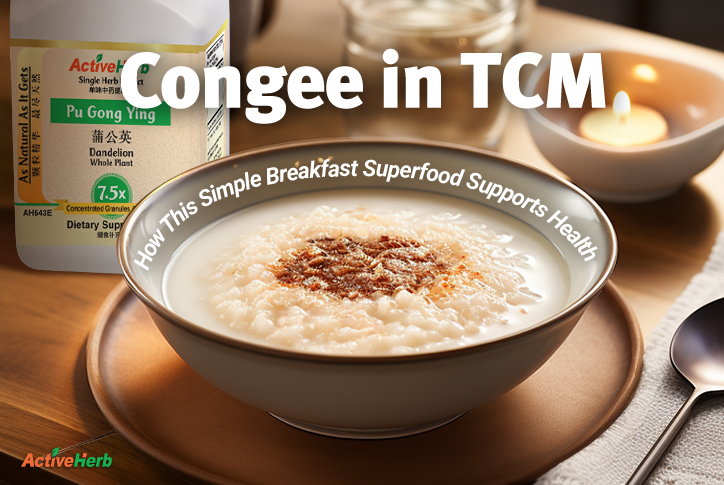Congee in TCM — How A Simple Breakfast Superfood Supports Health

Plain congee has the appearance and consistency of medieval peasant gruel. It makes oatmeal seem gourmet in comparison. At first glance, congee’s blandness and simplicity of ingredients are the antithesis of a breakfast superfood like an açai bowl or protein smoothie.
But for over 4,000 years, congee has been a staple in China, and approximately 2,000 years ago, it started being used medicinally. So why is this bland rice porridge considered so healthy in TCM?
What Is Congee?
Simply put, congee is rice porridge, a fundamental concoction of two ingredients: white rice and boiled water, lots of water, usually much more water than what’s used in oatmeal and non-porridge rice. As with any dish, you can get as creative as you want, adding an infinite number of ingredients. In Traditional Chinese Medicine (TCM), a doctor may prescribe congee mixed with certain medicinal ingredients that are commonly used as food in China.
In the West, so-called diet experts and health bloggers view rice as a dirty four-letter word. Eating white rice makes you fat, the thinking goes in the Western health blogosphere. However, in the Orient, rice is symbolic of fertility and life. In TCM, plain white, super starchy rice is considered easy for the system to digest and provides energy. (Never mind that in Japan, it’s used to fatten Sumo wrestlers; they still need quick bursts of energy to do their thing in the ring.)
Meanwhile, water serves as congee’s base, providing hydration and the porridge-like consistency that Goldilocks loves.
What Is Congee Used For In TCM?
Again, congee can be combined with virtually any combination of medicinal herbs and other nutritive ingredients. But even basic congee, according to TCM theory, helps harmonize bodily energy. This especially includes Qi (vital energy) and the branch of Qi, Yin, which controls the Blood, fluids, bones, Heart, Liver, Spleen, Lungs and Kidney organ systems.
“Congee detoxes” haven’t yet caught on as a health trend in the West. But in China, rice porridge helps support detoxification and cleansing by eliminating accumulated toxins and waste.
One of the easiest ways to “elevate your congee” experience is by adding single herb extract granules. For instance, to further support eliminating Phlegm and Dampness in the body, you can add specific herbal extract granules such as dandelion and burdock. By supporting the elimination of excess heat (which gives rise to Dampness and eventually Phlegm), the congee and auxiliary herbs may improve your skin from the inside out.
Millions of people have chronic digestive problems. Congee soothes the stomach, which is why it’s prescribed by TCM doctors when Spleen Qi is deficient. A deficiency of Qi in the Spleen channel produces weak digestion. Weak digestion and the accompanying Spleen Qi deficiency can also occur from illnesses, giving birth, being overworked, and other forms of stress. Who would have thought that a simple bowl of rice porridge would be just what the doctor ordered?
If you want to strengthen your digestion and replenish Spleen Qi, combine herbs like ginger or licorice root with congee.
In addition, congee may be easier to digest for those who have difficulty swallowing.
It’s doubtful that congee will one day supplant chicken soup in Western households. However, if you want to support your immune system, combine congee with immune-supporting herbs such as astragalus root and codonopsis root.
How Do You Make Congee in TCM?
Before you start going crazy with congee experimentation, learn the basics. To make a simple bowl of congee, you’ll need just 3 ingredients:
- 1 cup of rice
- 6-8 cups of water (adjust for desired consistency; more for gruel-like consistency and less for a thicker, oatmealy mouthfeel)
- Pinch of salt (optional)
To cook, you simply rinse the rice thoroughly until the water runs clear. Next, in a large pot, combine the rinsed rice and water. Add the optional salt and then bring the mixture to a boil. Simmer for 1-2 hours and stir occasionally until the congee reaches your preferred consistency and serve hot.
You can use the 5 tastes of TCM to further meet your health goals. For instance, ingredients like cinnamon twigs and jujube fruit (Chinese red dates) with a “Gan” or sweet taste profile help fortify Spleen Qi and drain excessive dampness.
If you get treatment from an acupuncturist, ask them which ingredients you should add to congee for your unique health concerns and constitution.
Do you eat congee to support your health? Let us know what ingredients you add to it. Got a favorite congee recipe? Share it!






